We would like to invite our parents and interested parishioners to some workshops so they can learn about the strategies we are implementing. The first workshop will be April 25th from 7-8:30PM in the church basement. Parents will experience an activity for each intelligence for one skill. They will also take the on-line Multiple Intelligence assessment their student took and discover their own intelligence strength. The second workshop will be on technology and web tools. This will be on Saturday, May 12th from 9-10:30AM. The third workshop will be a trip to our virtual museum, the success of our project, and where we will go from here. The date for this has not been determined.
I would like to note here that Father Tom sent me an email today encouraging us in our project! He has been very supportive of this process and truly believes in what we are doing. That has inspired all of us! Thank you Father!
What a fun day! The students were very excited about getting into their research groups! Students were grouped by their interests. All the students who were interested in school buildings of the past formed a group. Students interested in the people of the past who played a role in American education, including some of the saints, were put in another group and so on. This group of students will do their research collaboratively. The students were then given a list of activities for each topic to choose from to be their vignette for our virtual museum. The students could choose from the list or develop one of their own. The activities were created to reflect each intelligence for each topic. For example, if the student's multiple intelligence strength is musical and their interest was an invention affecting American education, they could write a song about the printing press, or create a jump rope rhyme. Finally, the students were given a rubric so they know what their project must contain for assessment purposes. The rubrics are based on the Content Standards for Social Studies. We were excited by the children's excitement.
I floated from room to room observing the process and helping when I could. I noticed something that was very interesting to me. The younger students (K-5), seemed to be excited about their intelligence smarts, what their project was going to be, and how they were going to do it. They were able to form questions about what they wanted to learn quite easily. The older students (6-8) seemed to be more concerned about which project would be the easiest to accomplish the rubrics to get a decent grade. The questions about what they wanted to learn were harder to extract. Any thoughts about this difference of approaches?
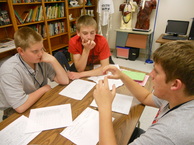 A research group beginning to think about what they want to find out and how they can use that information in their vignette.
| 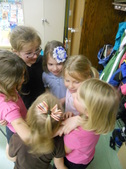 Kindergarten and first graders forming their research group! A picture is worth a thousand words!
|
Today the students were introduced to KWL Charts. Under the "K", students listed things they "know" about "American Education". Under the "W" they listed things they "want to know" in the form of questions. When the project is completed, we will go back to these charts and under "L" we will list the things we "learned". This process seemed to go very smoothly. Some of the classes had used KWL Charts in the past so their familiarity helped the process along. We were impressed by all of the knowledge the students already have about American Education and by all of things they still want to know!
After school the faculty gathered to debrief and to discuss how the next project day will look. That will be the day students will choose a topic and form research groups. Together, we outlined the steps we felt to be the most appropriate and those the teachers felt most comfortable in doing. We also looked at some webtools that would help with the research process. One of these is called "Symbaloo". It functions in a similar way as the "Favorites" section of your web browser only it can be accessed from any computer! The teachers, especially of the younger grades, will be able to put the sites they want their students to visit in "Symbaloo" and organize them by the topics of the project. It's a cool little tool!
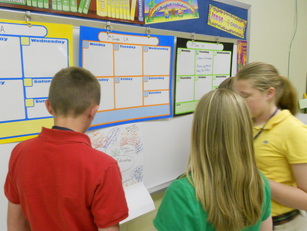 Our sixth, seventh, and eighth graders reviewed Day 2's ideas to form questions about what they want to know to list on their KWL Charts.
| |
On Day 2 of our new adventure, we acquainted our students with what our project is going to be about, American Education, Past and Future and what the end product will look like. Teachers used their Smartboards to show the students a web of the main categories of the project. The categories include people, events, tools, inventions, the influence of the Catholic Church, school buildings, and the school day. Students then brainstormed their ideas for each category. This was an amazing process to watch. I was surprised how many ideas the students have! They were oozing with them!
We then showed our students this website which also houses our virtual museum. When the projects are finished, they will be uploaded to the museum. This allows our students to use multi-media that best fits their multiple intelligence strength.
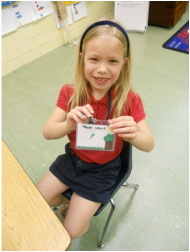
This is one of our second graders showing the lanyard and badge she made on Day 1. The badge has the student's name and their multiple intelligence strengths listed on it in words or in pictures. By having the students wear the badges during "project time", the teachers are able to assist them more quickly with a quick glance to see in what intelligences they are working.
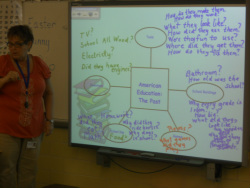
Mrs. Halker is shown here with her Smartboard web. You can see all of the ideas our kindergarten and first grade students generated!
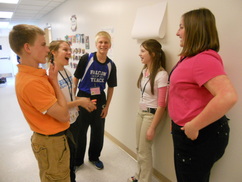 Our 7th and 8th grade students worked together in small groups. The groups rotated around to different charts on the walls and brainstormed their ideas there.
| |
Yesterday we started our school wide project: "American Education: Past and Future"! It is very exciting and a bit nerve racking to start an adventure like this! I am anxious to see how our students react! The project will be implemented using the multiple intelligences and project based learning. The idea is to help students learn in the way they learn best and to let them develop the project in a way that interests them.
Students explored each intelligence to get an idea of what their individual strengths are. The teachers in grades K-3 acted out a skit that demonstrated each of the intelligences. The students loved it! Our 4th and 5th grade students are each making a chandelier. The "bulbs" will be color coded to each intelligence. Students will attach the "bulbs" of their intelligence strengths.
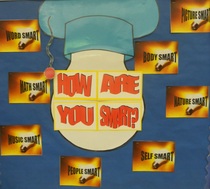
Mrs. Schroeder is making sure her students have a visual aid to help them remember each of the intelligences!
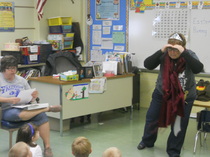
Mrs. Karl is narrating the story about a princess (Mrs. Halker) who goes on a dangerous journey to recover a precious stone stolen from the kingdom. The princess has to use all of her intelligences on the journey.
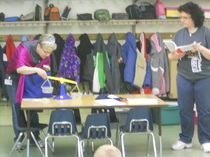
Mrs. Etzkorn is narrating the story about a princess (Mrs. Selhorst) who goes on a dangerous journey to recover a precious stone stolen from the kingdom. The princess has to use all of her intelligences on the journey.
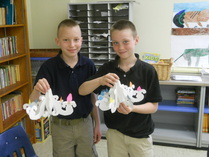
Two of our fifth graders are showing the chandeliers they made to demonstrate their "smarts"!



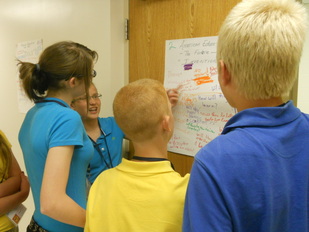



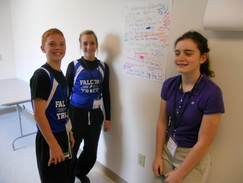




 RSS Feed
RSS Feed